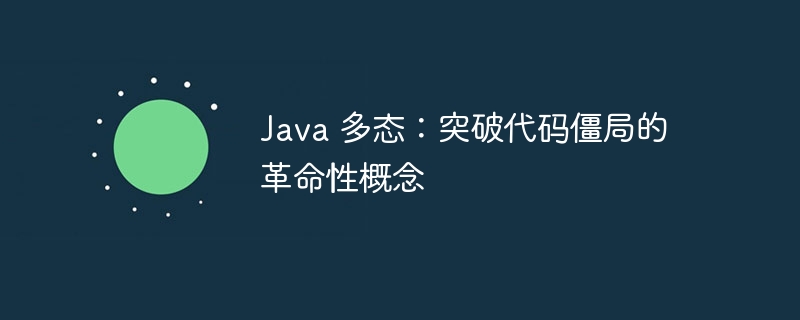Home >Java >javaTutorial >Java Polymorphism: A revolutionary concept that breaks code deadlock
Java Polymorphism: A revolutionary concept that breaks code deadlock
- WBOYWBOYWBOYWBOYWBOYWBOYWBOYWBOYWBOYWBOYWBOYWBOYWBforward
- 2024-02-20 12:06:21490browse

Java Polymorphism is a revolutionary programming concept that breaks code deadlock and provides programmers with more flexibility. In object-oriented programming, Java polymorphism is an important feature. By inheriting and overriding methods, different objects can have different behaviors for the same method. This article will delve into the principles, applications, and examples of Java polymorphism to help readers better understand and apply this concept. PHP editor Apple will explain Java polymorphism in detail so that you can easily master this key technology.
Polymorphism is an important feature of Object-orientedprogramming in Java. It allows you to use the same interface to handle different types of objects. This makes the code more flexible, simpler, and improves maintainability.
There are two main types of polymorphism:
-
Static polymorphism: This polymorphism occurs at compile time. It allows you to use different type objects to call the same method. For example, you can call the
speak()method using an object of classAnimal, even if theAnimalobject is actually aDogorCatObject. -
Dynamic polymorphism: This polymorphism occurs at runtime. It allows you to use the same method to call different types of objects. For example, you can use the
speak()method to call an object of classAnimaleven if theAnimalobject is actually aDogorCatObject.
Demonstration of polymorphism
The following code demonstrates polymorphism in Java:
class Animal {
public void speak() {
System.out.println("Animal speaks.");
}
}
class Dog extends Animal {
@Override
public void speak() {
System.out.println("Dog barks.");
}
}
class Cat extends Animal {
@Override
public void speak() {
System.out.println("Cat meows.");
}
}
public class Main {
public static void main(String[] args) {
Animal animal = new Animal();
animal.speak(); // prints "Animal speaks."
Dog dog = new Dog();
dog.speak(); // prints "Dog barks."
Cat cat = new Cat();
cat.speak(); // prints "Cat meows."
}
}
Output:
Animal speaks. Dog barks. Cat meows.
In this example, the Animal class is the parent class, and the Dog and Cat classes are subclasses. The Animal class defines a speak() method, which is overridden by the Dog and Cat classes respectively. When you call the speak() method, the actual method that is called depends on the type of object being called.
Benefits of polymorphism
Polymorphism has many benefits, including:
- More flexibility in code: Polymorphism allows you to handle different types of objects in the same way. This makes the code more flexible as it can adapt to new situations more easily.
- Simplified code: Polymorphism can make code simpler because it can reduce the amount of repeated code. For example, if you use polymorphism to handle different types of objects, you don't have to write separate code for each type of object.
- More maintainable: Polymorphism can improve the maintainability of code because it can make the code easier to understand and modify. For example, if you use polymorphism to handle different types of objects, you can more easily add new object types without modifying existing code.
in conclusion
Polymorphism is an important feature of object-oriented programming in Java. It allows you to use the same interface to handle different types of objects. This makes the code more flexible, simpler, and improves maintainability.
The above is the detailed content of Java Polymorphism: A revolutionary concept that breaks code deadlock. For more information, please follow other related articles on the PHP Chinese website!

